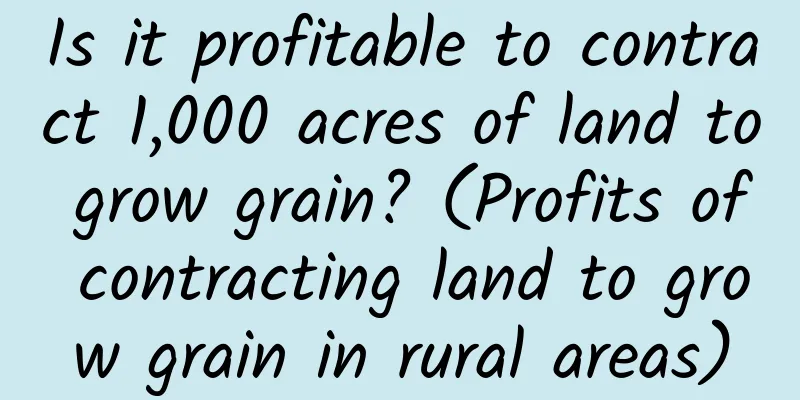Is it profitable to contract 1,000 acres of land to grow grain? (Profits of contracting land to grow grain in rural areas)

Is it profitable to contract land to grow crops in rural areas?Contracting 1,000 mu of land to grow grain is generally profitable . With the development of the economy, land rents are now expensive, land subsidies are small, and the overall price of grain is low, so profits are relatively low. You must be prepared for a lot of planting and a little harvest, and it is very hard work. However, if you use scientific management methods and advanced planting techniques, contracting land to grow grain crops is still profitable. How to manage contracted land for growing crops to get higher profitsTo make money by growing crops, four conditions must be met: a large area, own agricultural machinery, complete water conservancy facilities, and professional management personnel. 1. Large areaIf you want to make money by growing crops, you have to rely on the area. Currently, the cost of transferring large areas of land is also rising. This year, I am leasing land for 700-900 yuan per mu. Including arable land, pesticides, fertilizers, seeds, and labor, if you want to get involved in agriculture, you must consider the cost risk. Grain farming is a process of planting a lot but yielding little, with relatively little profit per mu, but when scale is achieved, the profits can be considerable. It is unrealistic to pursue high yields and high output values through large-scale planting, and the only way is to make use of scale benefits and increase income through scale. Therefore, contracting and operating land can also make you a high-income earner. But the prerequisite is to operate on a large scale. Contracting 3 or 5 mu is not cost-effective. It is considered large-scale operation only when the contract is at least 100 mu or 1,000 mu. The more land you contract, the lower the cost, because there are many intermediate links in the sale of agricultural materials. If you have more than 500 mu of land, you can get agricultural materials from the first-level dealers, or directly from the producers. This can save some of the price difference, and your scale operation can be a considerable economic benefit. 2. Own agricultural machineryOwning agricultural machinery is the most effective way to reduce costs. Some friends may say that purchasing agricultural machinery is also a considerable investment, but I want to tell you clearly that large-scale planting requires own agricultural machinery. A one-time investment will bring benefits for many years, and the cost will not be high when it is spread out. 100 mu of land can be tilled and leveled in one day, costing only 100 yuan for gasoline and diesel, but if it is done manually, it will take at least half a month and cost 3,000 yuan. Mechanized sowing, weeding, topdressing, spraying, irrigation, and harvesting only cost about 300 yuan, but if it is done manually, it may cost tens of thousands of yuan. Nowadays, large-scale contract farmers are all mechanized, intelligent, and large-scale planting, which can reduce costs, thereby obtaining returns and profits. Mechanization and intelligence also have relatively small risks and are more scientific. 3. Water conservancy facilitiesWater conservancy facilities are a major factor in ensuring production. They must be properly maintained during the slack season, and water conservancy projects must be built to strengthen the protection of the source of life, so that water resources can be used and allocated rationally and the goal of promoting benefits and eliminating harm can be achieved, which will ensure that they do not fall behind during the busy farming season. 4. Professional management personnelProfessional managers. Large-scale planting is different from small-scale planting, and the management of crops during the growing period is also different, so professional managers are essential. They must always pay attention to problems that arise with crops and be able to solve them as quickly as possible. The scientific, intelligent and mechanized planting pursues economies of scale. The planting cost has been reduced to the lowest, and there is no waste of production materials. Precise fertilization, formula application of pesticides, and standardized irrigation have reduced costs and increased benefits. The seeds are the latest developed seeds, and the yield increases year by year. For example, the rice yield is more than 1,500 jin/mu every year, and in high-yield years, it averages 1,900 jin/mu. As the yield increases, the output value increases, the efficiency increases, and the benefits are maximized. |
Recommend
Can saffron be grown in the north? Where can it be grown?
Growing Saffron in the North Flowers like saffron...
How to water green radish with beer
1. Add water for irrigation Beer can effectively ...
Advantages and disadvantages of London Eye rose: It is a rose that is relatively easy to grow.
The London Eye Rose is also known as the London E...
What to do if the roots of white flower rot
What to do if the roots of white flower rot: Cut ...
Where is the best place to plant Polygonatum odoratum
Polygonatum odoratum planting area Wild Polygonat...
How to make asparagus fern sprout more and how to pinch the new buds
1. How to make asparagus fern sprout more 1. Spra...
What to do if Impatiens balsamina wilts
Causes of wilting Too much water or drought Impat...
How often should I water the newly planted green radish?
1. How often should you water? After it is newly ...
When and how to plant chili peppers
Pepper planting time The planting time of chili p...
A handful of green radish, 1 spoon of sugar on asparagus fern, and it will climb the wall in a month!
Feed asparagus fern 1 spoon of sugar and it will ...
How to water the Yale Dance
Spring and Autumn Watering These two seasons can ...
How to breed Xiaoyu
1. Maintenance methods 1. Temperature: It can wit...
What are the methods of raising pigs?
my country is the world's largest pig-raising...
When to prune your money tree, if you do it at the right time, it will grow stronger next year!
1. Pruning time Money trees are usually pruned in...
How many kilograms of sweet potatoes can be produced per mu?
How many kilograms of sweet potato are generally ...









